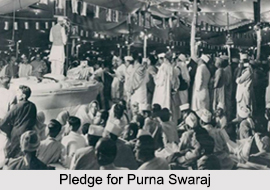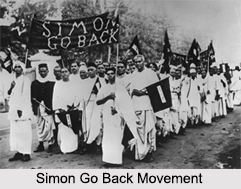 Purna Swaraj Declaration or the Declaration of the Independence of India was announced by the Indian National Congress on 19th December 1929. This came as a result of the fights of Congress and Indian Nationalists for the Purna Swaraj during the British era in India. On 31st December in the year 1929, Indian National Congress raised the Indian Flag on the banks of Ravi River at Lahore. The Congress, on 26th January 1930, at that time led by Gandhi and Jawaharlal Nehru, issued a Declaration of Independence, or Purna Swaraj. Purna Swaraj can be loosely broken down in Sanskrit language into "purna" meaning complete, "swa" meaning self and "raj" meaning rule, thus "complete self-rule". The declaration included the readiness to withhold taxes, and the concept of Purna Swaraj. Congress asked the Indians to consider the 26th of January as the Republic Day. Indian flag was hoisted publicly by Congress volunteers, nationalists and the public. But Bhagat Singh was the first person who gave call for the Purna Swaraj.
Purna Swaraj Declaration or the Declaration of the Independence of India was announced by the Indian National Congress on 19th December 1929. This came as a result of the fights of Congress and Indian Nationalists for the Purna Swaraj during the British era in India. On 31st December in the year 1929, Indian National Congress raised the Indian Flag on the banks of Ravi River at Lahore. The Congress, on 26th January 1930, at that time led by Gandhi and Jawaharlal Nehru, issued a Declaration of Independence, or Purna Swaraj. Purna Swaraj can be loosely broken down in Sanskrit language into "purna" meaning complete, "swa" meaning self and "raj" meaning rule, thus "complete self-rule". The declaration included the readiness to withhold taxes, and the concept of Purna Swaraj. Congress asked the Indians to consider the 26th of January as the Republic Day. Indian flag was hoisted publicly by Congress volunteers, nationalists and the public. But Bhagat Singh was the first person who gave call for the Purna Swaraj.
Initiation of Purna Swaraj
Before 1930, Indian political parties openly considered the concept of political independence from the United Kingdom. The All India Home Rule League had been advocating Home Rule for India. All India Muslim League also favoured dominion status and opposed the calls for outright Indian independence. On the other hand, Indian Liberal Party, the most pro-British party, opposed India`s independence and even the dominion status. They thought about the fact that it may weaken the links between India and British Empire. At that time, Indian National Congress was at the top of the national debate. Congress leader and famous poet Hasrat Mohani was the first activist to demand complete independence (Purna Swaraj) from the British in 1921 from an All-India Congress Forum. Other dominant Congress leaders such as Bal Gangadhar Tilak, Aurobindo and Bipin Chandra Pal had also advocated explicit Indian independence from the Empire.
 Following the 1919 Jallianwala Bagh massacre, there was considerable public outrage against the British rule. European civilians and officials were the targets and victims of violence across the country. In 1920, Gandhi and the Congress committed themselves to Swaraj, described it as political and spiritual independence. Between 1920 and 1922, Mahatma Gandhi led the "Non-Cooperation Movement" to oppose the Rowlatt Acts and the denial of political and civil freedoms and to exclude Indians from the government.
Following the 1919 Jallianwala Bagh massacre, there was considerable public outrage against the British rule. European civilians and officials were the targets and victims of violence across the country. In 1920, Gandhi and the Congress committed themselves to Swaraj, described it as political and spiritual independence. Between 1920 and 1922, Mahatma Gandhi led the "Non-Cooperation Movement" to oppose the Rowlatt Acts and the denial of political and civil freedoms and to exclude Indians from the government.
Simon Commission and Nehru Report
In the year 1928, the British Government further outraged the Indians by forming a seven-man committee, which was led by Sir John Simon. This Simon Commission was formed intentionally by the British Government to reform Indian constitutional and political structure. Meantime, sudden death of Lala Lajpat Rai due to severe beatings by the British police made the situation even worse. Then, Congress appointed an all-Indian commission to propose for Indian constitutional reformation. The commission, led by Motilal Nehru, was joined by other Indian political parties as well. The Nehru Report demanded India to be granted with self-governance under the dominion status within the empire.
Declaration of Purna Swaraj
The report and the proposal were refused by the British Government. But the report was quite controversial within the Congress even. Younger leaders like Subhas Chandra Bose and Jawaharlal Nehru demanded complete and explicit break from all bonds with the British. Jawaharlal Nehru was influenced by the idea of Bhagat Singh, which he introduced in a resolution demanding during 1927. The proposal at that time was rejected by Gandhi"s opposition. Then finally in December 1928, Congress session was held in Kolkata and Gandhi proposed a resolution that called for the British to grant dominion status to India within two years. On 31st October 1929, the Viceroy of India, Lord Irwin announced that the government would meet with Indian representatives in London for a Round Table Conference. To facilitate Indian participation, Irwin met with Mohandas Gandhi, Muhammad Ali Jinnah and out-going Congress President Motilal Nehru to discuss the meeting. As a result of this meeting, President Jawaharlal Nehru finally hoisted the flag of India upon the banks of the Ravi River in Lahore on New Year`s Eve. Later, Lahore became a part of Pakistan.



















